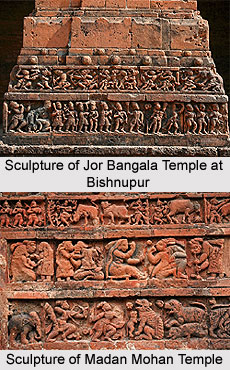 Pala-Sena period is considered as the glorious era as far as temple sculpture of West Bengal is concerned. Bengal witnessed a lot of sculptural work between the ninth and twelfth centuries. Recurring features of the temple sculpture of West Bengal are the terracotta reliefs, bamboo frameworks and bas reliefs. The regular architectural elements of these temples include double temple structure or `jor bangla,` use of bricks and laterite, lavish decorations and others. The influence of folk architecture is also apparent in the art and sculpture of West Bengal temples.
Pala-Sena period is considered as the glorious era as far as temple sculpture of West Bengal is concerned. Bengal witnessed a lot of sculptural work between the ninth and twelfth centuries. Recurring features of the temple sculpture of West Bengal are the terracotta reliefs, bamboo frameworks and bas reliefs. The regular architectural elements of these temples include double temple structure or `jor bangla,` use of bricks and laterite, lavish decorations and others. The influence of folk architecture is also apparent in the art and sculpture of West Bengal temples.
Gupta style assumed a regional character in temple sculpture of Bengal. This regional style contributed to the development of art-style in the most prolific period of Bengal sculpture between the 9th and 12th centuries. The thematic range of Pala-Sena art is wide. All the major and even minor iconic forms associated with Brahmanical Hinduism, Buddhism and Jainism has been represented in the sculptures of this period. Pala-Sena sculptures are carved out of a variety of black stone. Human figure occupies the central position in the Pala-Sena Art. The basic physical type is borrowed from Gupta art. Nevertheless a host of new elements are added to achieve a different aesthetic impact. From the stunted but bold physical types of the 8th century, gradually emerges soft sensitive form with clear outlines in the 9th-10th century. Almost all figurines are moulded into high relief and the trunk limbs with a subdued vigour. Slim, slender and elongated physical type was preferred in the 11th century. The sensitiveness of the facial expression persists. By the12th century, the style lack innovation.
However the precision of carving in details and the command in handling wide range of iconic formulas reveal the talent of the sculptors.
Bishnupur was the capital of Mallabhumi dynasty. Bishnupur houses 30 temples (17th-18th century) that are a treasure-trove of terracotta sculptures. Lord Krishna is deified in most of these temples. On the southern outskirts are seven temples which are made of laterite. The most popular eka ratna temples of Bishnupur are all made of laterite. Jora mandir is a group of three temples that has on its laterite walls tales from the Ramayana sculpted. Exquisite sculpture of scenes and illustrations of current events and trends on the walls, the panels and sculptured pillars are some of the remarkable features of these temples. Various stories of the Puranas and phases of Krishna Lila have been reproduced on the walls and pillars.
Laterite stones have been used in building some temples and the temple of Gokul Chand at Sealdah village in Bankura district is a unique example. It is known for its panelling work. Some of the Rekha deul temples show a clear impact of Orissa type of temples. These are also fine specimens of sculpture. Bengal sculptors are known for their delicate execution of image work.
Hanseswari temple at Bansberia, Hooghly is another example of fine sculpture of West Bengal. It is also known for its terracotta works. Ananta Basudeba temple is alo fused with terracotta sculpture that is located in the complex of Hangseswari temple.
Madanmohan Temple has number of sculptures and designs that depict the influence of various generations` Zamindars of the village.
Krishna Chandra Mandir (A.D. 1751-1752), with its 25 steeples, is another popular landmark. Scenes from the epics are depicted on its terracotta walls. Lalji Mandir (A.D.1739) with 25 steeples and Pratapeshvara Mandir (A.D.1849) of the rekha style are worth mentioning here. These temples are about 400 yrs old.



















